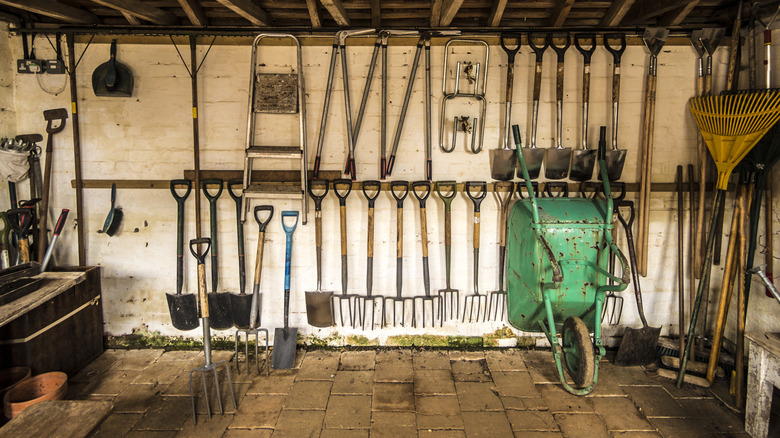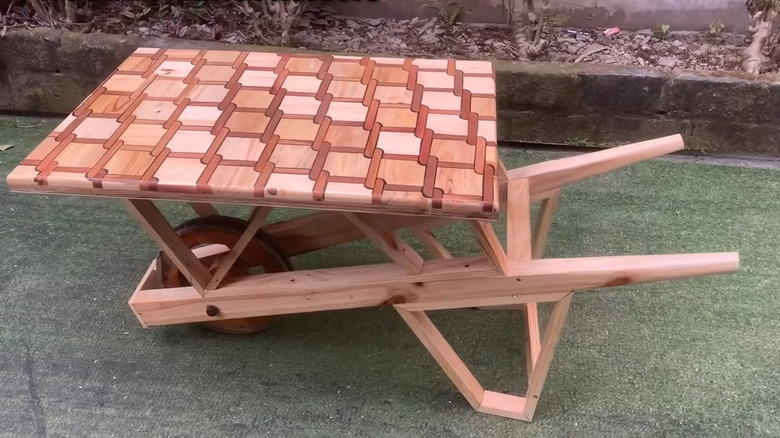DIY A Rustic Coffee Table Using An Unexpected Gardening Tool
We may receive a commission on purchases made from links.
Are you thinking about building a stylish DIY coffee table but aren't sure where to start? Your garage or storage shed may just provide you with some unexpected inspiration. If you have an old wheelbarrow that's no longer in use, you can repurpose it to make a trendy, yet sturdy base for a DIY coffee table. From there, it's just a matter of adding a tabletop that matches your desired aesthetic.
Building a wheelbarrow coffee table is a simple enough DIY task that doesn't demand much skill, and won't require many tools. First things first, you want to clean this gardening tool before dragging it into the house. This cleanup should involve removing any dirt particles caked on to the wheelbarrow — you don't want to track these into the living room. You may also need to do a bit of sanding, then seal the metal and paint over the rust. With this task out of the way, all you need to do is construct and attach a tabletop you like. We explain how to do this below.
Make a coffee tabletop with a wheelbarrow as a base
The wheelbarrow itself will serve as a sturdy base for the coffee table, so all you really need to worry about is constructing the tabletop. Your options are limitless here, but let's go over a few. If you prefer a minimalist look that showcases the wheelbarrow and doesn't take up too much of your time, opt for a sheet of glass. To be strong enough for a tabletop, the glass needs to be either tempered or annealed. Annealed glass is not particularly robust, but you can use it if you find a sheet that's ½ inch or thicker. Tempered glass may be a better option, since it's manufactured to resist cracking. If it does shatter, the pieces are small and harmless. You can customize and order a suitable sheet of glass easily on Amazon.
If glass isn't your thing and you're looking to match the barn aesthetic afforded by the wheelbarrow, consider using planks of wood as the tabletop instead. You may have some kicking around in the garage or shed, and as long as they're roughly the same thickness, making an even surface is a breeze (otherwise buy some new ones). Lay the boards together, plane the tops and edges so that they align perfectly, and join them with a wood glue. Keep the planks clamped until the wood glue has had enough time to dry. You can then sand the top and stain it if you like.
Best way to attach a tabletop to a wheelbarrow
The way you attach the tabletop to the wheelbarrow depends on the top's material. If you're going with the glass top, you'll have to use a type of glue that can make a glass-to-metal bond. The options here include super glue, glass adhesive, and epoxy glue. Regardless of the gluing method, make sure that the glass sheet will fit on the wheelbarrow and the two surfaces come into contact. You may run into an issue where the wheelbarrow top isn't perfectly level, in which case you may have to shim the leg supports or the wheel to raise one of its sides. If no such issue presents, clean both the glass and the metal, apply glue to one of the surfaces per the manufacturer's instructions, and press the glass sheet down on the wheelbarrow. If possible, clamp the top to the wheelbarrow frame to help achieve a strong bond.
Wooden tops are easier to affix to a wheelbarrow "frame" than glass ones. You can use small u-bolts like these ones from The Home Depot to secure the top to the wheelbarrow's handles, then attach the rest of the top to the edges of the tray by drilling in coarse-thread screws. To achieve a stable bond between your makeshift frame and the top of the table, glue the surfaces before you screw them together. The best glue for bonding metal to wood is epoxy, since it's particularly robust and can help fill in gaps between the two surfaces.

